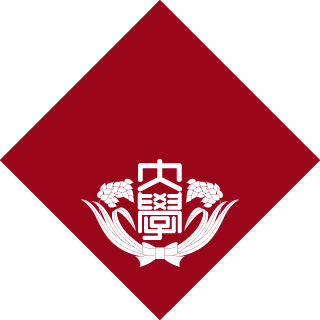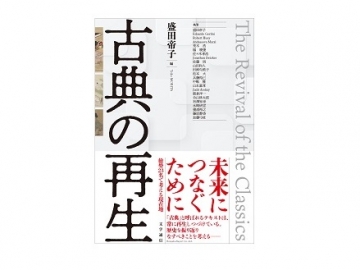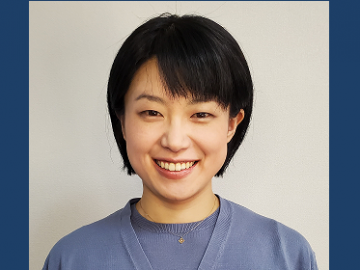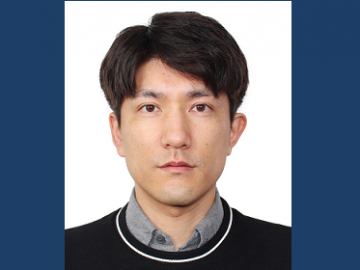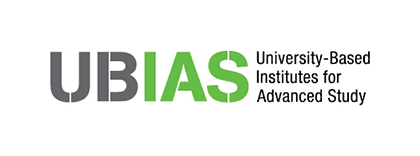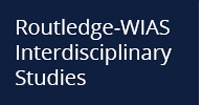Researchers
In academic year 2019, we welcome a cohort of eight researchers at the Institute. Each member provides a short snippet of his/her work.
OKAWA, Hirotada
Nonlinear elliptic partial differential equations often appear in Physics and Engineering. Numerical methods are quite helpful when analytic methods break down, but the following issues should be resolved: (i) Transformation from Nonlinear elliptic partial differential equations to a set of nonlinear equations, (ii) Method to solve it. However, in particular, there is no perfect method for issue (ii). Recently, we proposed a new method for issue (ii) and I would like to construct useful numerical methods in practice.
GIANNETTI, Niccolo
Born and raised in Florence, Italy, while practicing the Japanese martial art “Judo”. This gave insight on Japanese culture and educational methods. Graduated at the University of Florence in the undergraduate and graduate courses of Mechanical Engineering. In September 2013 moved to Tokyo, Japan, for a Doctoral program in Mechanical Engineering and found a fascinating, as well as challenging environment. Studying and working in Japan expanded my knowledge, research network and cultural points of view.
YAMAMURA, Shu
My research interests lie at the crossroads of interdisciplinary research between urban planning and social sciences. My current research projects and interests relate to knowledge-creating industry clusters in Tokyo (ICT, animation, apparel design, etc.), business location theories, knowledge-city policies, inner city problems and revitalization, and placemaking for innovation.
YOKOTE, Koji
In modern societies, we often encounter the problem of how to distribute limited resources among agents fairly. Examples include auctions, school choice problems and daycare allocation. My research interest is to theoretically analyze “desirable” allocation rules in these allocation problems. I tackle this issue using the techniques in game theory and discrete mathematics.
LOTTAZ, Pascal
I am a historian and an International Relations scholar, and my main interest is the study of neutrality. I am trying to understand the impact of neutral actors (mostly countries) on the international community during different security regimes and in times of war. I enjoy collaborative research projects, like my first book, “Notions of Neutralities” (Lexington Books, 2018) which was an edited volume created with 11 other scholars about the change of the neutrality concept over the past 500 years.
AKIYAMA, Tetsu
Have you visited Central Asia? This underexplored region is a hidden frontier with enormous potential for indispensable insights on how our modern world came to be, and where it might be headed. I intend to clarify the dynamics of modern Central Asian states from a historical sociology perspective, and to put my findings to pro-active use in the community and around the world.
KIM, Younglong
My research aims to clarify the relationship between law and literature focusing on the Tokyo Trial which gave a great impact on forming legal system in postwar Japan.
YASUOKA, Yoshifumi
I studied architecture at Waseda University, where I also had my first opportunity to participate in an archaeological excavation in Egypt. Since then, Egyptian art and architecture has been the main research interest. After having studied Egyptology in several universities in Europe, I submitted my PhD thesis on the Ancient Egyptian columns at Heidelberg University in Germany. Through interdisciplinary studies, I endeavour to rewrite art and architectural history.
Activity
UBIAS Topic of the Year 2018 Event “Aging – Life, Culture, Civilization” Joint Workshop held at Nagoya University by Waseda Institute for Advanced Study and Nagoya University’s Institute for Advanced Research.
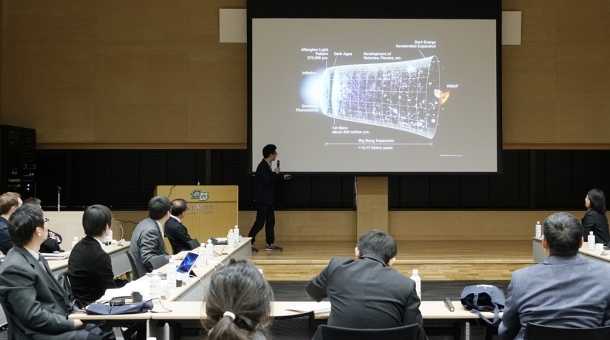
Dr. Kimura presenting at the UBIAS Workshop
Over the two days of Wednesday December 19, and Thursday December 20, 2018, Waseda Institute for Advanced Study (WIAS) and Nagoya University’s Institute for Advanced Research (IAR) held a joint workshop for the UBIAS Topic of the Year 2018 event: “Aging – Life, Culture, Civilization” at Nagoya University. See here for the workshop program. During the workshop, two researchers from WIAS, four from Nagoya University, and five from Nanjing University in China gave presentations on “aging” from the viewpoint of their own specialist fields. The program from the day is available here. This newsletter offers a brief introduction to the content of the lecture given by Assistant Professor Rampei Kimura (WIAS) during the workshop.
———————————————————-
“Building and testing gravitational theories”
Assistant Professor Rampei Kimura
I gave a lecture on the present and future development of cosmology, focusing on gravitational theories, the main content of which I briefly describe below.
There are countless stars in the universe; they form galaxies, and the distribution of galaxies consists of huge filamentary structures as in Diagram 1. We also know that the universe has been constantly expanding for 13.7 billion years from the beginning. The theory of general relativity, presented by Einstein in 1915, is a theory that describes gravity, and the expansion of the universe is described using Einstein’s equations. When using these equations to describe the universe, we predict that the universe, which has been expanding from the beginning, will eventually start shrinking due to the fact that gravity is an attractional force. However, it became clear from observations of supernova presented in 1998 that, surprisingly, the expansion of the universe, which had been decelerating, began accelerating several billion years ago. As this is inconsistent with predictions made using Einstein’s equations, it is thought that there is some form of new, hidden physics.
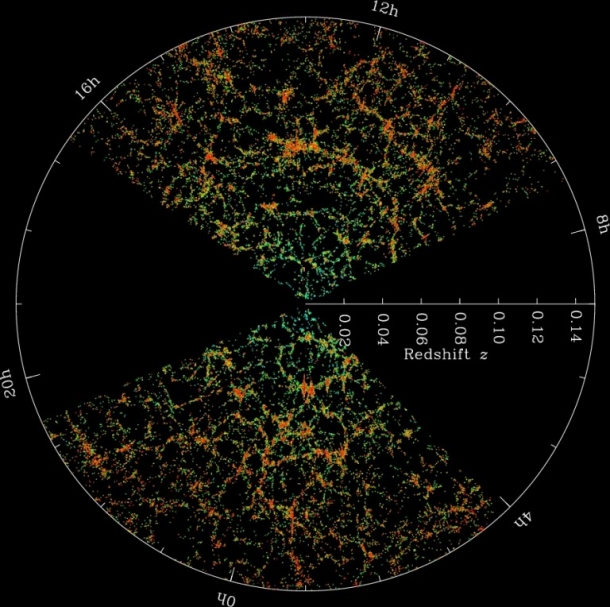
Diagram 1: Distribution of the Milky Way (Reprinted from https://www.sdss.org)
The theory of general relativity has been verified through various observations and experiments, and is known to agree with theoretical predictions within our solar system with an excellent accuracy. In other words, there is no room for doubt. On the other hand, we do yet fully understand whether this theory can be applied on a scale larger than the solar system (as we know that it does not explain the accelerating expansion of the universe). Therefore, the possibility that “the theory of general relativity is correct in limited circumstances, and a theory of gravity with a larger framework exists” is being considered. For example, in the same way as we understand that Newton’s theory of gravity can be applied in circumstances where the influence of gravity is extremely small (the gravity on the surface of the earth, etc.), and the theory of general relativity exists as a gravitational law with a larger framework, if there are inconsistencies when a law is applied to a small framework then the possibility exists that there is a theory with a large framework that includes this small framework.
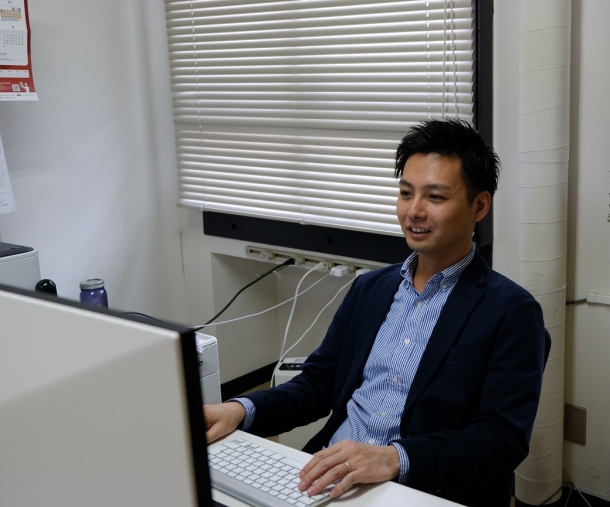
The author Dr. Kimura
Thus, in order to investigate whether there is a gravitational theory with a large framework, I am carrying out research by constructing new theories of gravity and testing them by comparing observational and experimental data. At the same time as revealing the laws of gravity that control our universe, this should be able to answer the question of how the universe has evolved. I wish to continue challenging the question of how far we can understand our universe of epic proportions.
2018 Waseda Research Award winners
Waseda University established the Waseda Research Award in 2014 to promote innovative research at the university and disseminate its results around the world. The award honors scholars spearheading large-scale research projects, as well as emerging researchers whose work has had significant impact abroad.
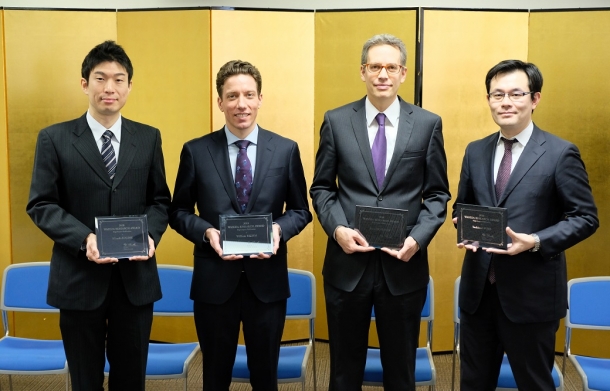
Dr. Sugime, Dr. Brehm, Dr. Hofmann, Dr. Fujie
Four WIAS members received the 2018 Waseda Research Award:
Hisashi Sugime, Assistant Professor*
Toshinori Fujie, Associate Professor**
Will Brehm, Assistant Professor
Reto Thomas Hofmann, Associate Professor
*as of March 2019
**as of October 2018
Below we spotlight the research activities from two of the recipients.
—————————————————————————
“Researching National and Regional identity in Southeast Asian Schools”
Assistant Professor Will Brehm
The Association of Southeast Asian Nations (ASEAN), a multi-national institution comprised of 10-member states, is trying to build a regional identity. After successfully establishing an “economic community”, which started in 2015, where capital and people move freely across national borders, ASEAN and its partners now aim for a “socio-cultural community” that “engages and benefits its people, and is inclusive, sustainable, resilient, and dynamic.” The plan is to achieve this vision by 2025. Part of the envisioned socio-cultural community intends to construct a regional identity in hopes of uniting Southeast Asia’s 600 million people.
What does an ASEAN identity look like? Is it possible or desirable to establish a common identity across the diverse peoples of Southeast Asia? And how would a regional identity exist alongside national-identity given the divergent memories of history?
My current research project grapples with these questions by exploring issues of shared history, national identity, and schooling in the countries along Southeast Asia’s Mekong River delta: Cambodia, Thailand, Vietnam, Laos, and Myanmar. Schools play a central role in identity creation. Organized by nation-states, they advance a particular version of history, based on some mix of fact, myth, and propaganda, in order to build a sense of social cohesion among citizens as well as legitimatize ruling powers.
But can social cohesion be built beyond the nation-state?
The use of education to construct social cohesion at the regional level remains nascent in Southeast Asia. One effort has been spearheaded by UNESCO Bangkok, a partner of ASEAN, through its Shared Histories Project. This project aims to develop a common set of history lessons across Southeast Asia to promote, at least in theory, mutual understanding and peace. UNESCO labels this regionalization strategy “shared history.” By teaching a common history, children in one country supposedly begin to feel what Benedict Anderson called “deep, horizontal comradeship” with those in other countries. Memories of past events and historical figures become shared, uniting people together despite their differences. Although Anderson theorized “imagined communities” with respect to the emergence of state nationalism, UNESCO Bangkok assumes a similar dynamic can work across a region: an imagined regional community that can be inclusive and homogenous.
Is building a regional identity so simple?
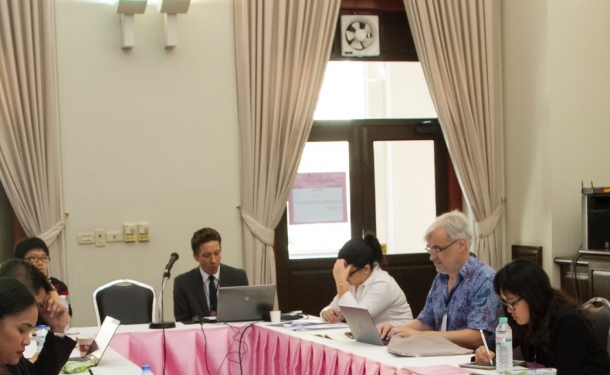
Photo 1: Will Brehm presents his research at the 2017 SEASIA conference in Bangkok, Thailand
Over the past three years, I have worked in collaboration with researchers in the region as well as across the globe to study the debates, problems, and opportunities of national and regional identity-making inside education systems in the Mekong.
In Thailand, Vong-on Phuaphansawat and I have shown how the government manufactures consent for itself by allowing students to think they are learning to be critical readers of history: although alternative, anti-elite conceptions of Thai history are presented in textbooks, they are written in such a way that a student is likely to conclude the government’s version is correct.
In Cambodia, I have researched the ways in which civil servants have developed the new high school history curriculum framework, balancing the demands of the state with those of UNESCO Bangkok. Even at the level of career bureaucrats, political contestation over national and regional identity can be found.
In Vietnam, my colleague, Hang Duong, has shown the ways in which the conception of citizenship has taken on new meanings as the country embraced capitalism after the economic reforms known as doi moi. The case of Vietnam shows to how the malleability of terms, such as “citizenship,” can reinforce the political status quo.
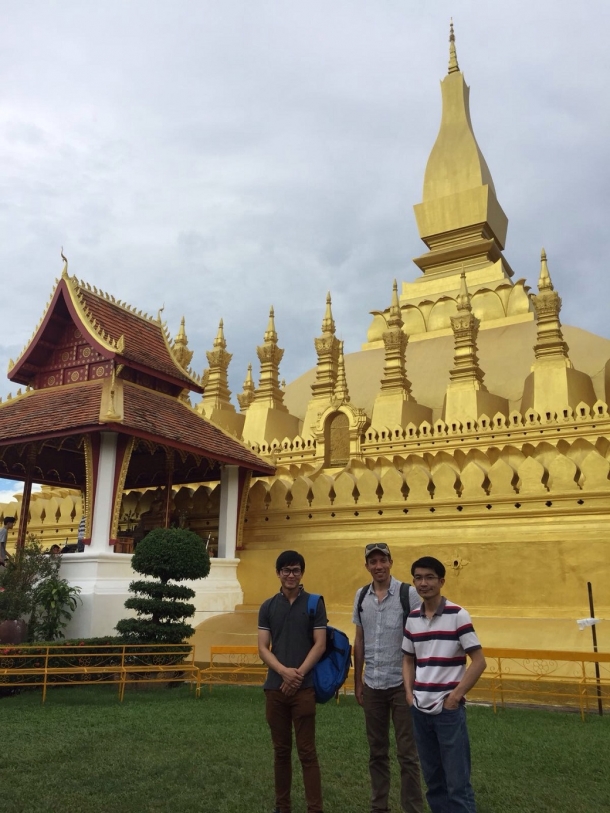
Photo 2: Larvankham Somsanit, Will Brehm, and Tick Thongdeuane visit Pha That Luang in Vientiane, Laos
In Laos, Larvankham Somsanit, Tick Thongdeuane, Yasushi Hirosato, and I have compared the policy rhetoric of “unity in diversity” with the reality of ethnic minority exclusion. Although the state wants to create inclusion among the many ethnic groups, teachers and students are more likely to perceive commonality among their local communities rather than with the entire nation, let alone region.
In Myanmar, my colleague Anna Zongollowicz, highlighted the gaps in state-sanctioned history to show how young people have used memories and myths, to write a history that is inclusive. Although exclusion of some ethnic minorities is at the heart of the state’s approach to historical memory, everyday citizens in Myanmar show alternative conceptions based on inclusion are possible.
Beyond national-level studies, Rosalie Metro and I have researched UNESCO Bangkok’s shared history project, highlighting the ways in which the organization’s careful attempts to steer around political controversies may have actually exacerbated nationalist tensions among ASEAN member-states.
The findings from my research project, which will be published in a co-edited collection with Yuto Kitamura (University of Tokyo), suggest regional identity in the Mekong is likely not possible in the near future. Historical memory evolves out of a process of intense debate and tension, which continues to be found at the level of the nation-state. The process is as much about excluding certain groups of people (ethnic minorities or those who advocate alternative versions of history) as it is based on inclusion. Overcoming these deeply ingrained historical memories at the regional-level will present challenges for the foreseeable future.
————————————————————-
“What happens when empires collapse? ”
Associate Professor Reto Thomas Hofmann
This is the question that I ask in my research about Japan’s transition from the age of empire to that of liberal democracy. Many historians have argued that Japan made this shift rapidly and unreservedly as a result of its defeat in World War II. According to this narrative, 1945 marks a clean rupture between a fascist regime that had sought to conquer Asia, and a democratic government that embraced pacifism. Indeed, Japan was a radically different country after the war: the military was gone, the emperor declared that he, too, was a human being, women could vote, workers could strike without fear of being jailed, freedom of expression was granted.
So progressive appeared postwar Japan, that few historians asked what actually happened to those men (they were mostly men) who had supported the prewar regime and its goals in Asia. We know that some of the highest-ranking military and civilian leaders were executed as war criminals, while others received jail terms and were excluded from public office. Others, still, retired to the countryside.
But it is still not very clear how the hundreds, if not thousands, of individuals who had occupied more minor positions during the war returned to their desks and found new ways to remain relevant in the 1950s and 1960s. In my research, I explore their postwar careers. These people include intellectuals who had theorized the Greater East Asian Co-Prosperity Sphere, activists who helped the police to quash the Left, and academics who produced the legal basis of Japan’s New Order—they were among those who, collectively, did their best to help the regime to win World War II. How did they reinvent themselves after defeat?
In attempting to answer this question, one challenge that I faced was how to choose the subjects of my study. I spent quite some time surveying potential candidates, and eventually I settled on a group of men who surrounded the political scientist Yabe Teiji (1902-1967). Yabe was known for his role in the Showa Research Association (Shōwa Kenkyūkai), the think tank that advised the wartime prime minister, Konoe Fumimaro. Historians have made wide use of Yabe’s diary, which relates in detail what senior figures in the bureaucracy, politics, and intelligentsia did and said during the crucial years leading up to Japan’s defeat. Almost no scholar, however, has systematically analysed the even more voluminous parts of the postwar sections of Yabe’s diary, which are just as revealing.
What was striking from reading those parts was just how much postwar elites—prime ministers, business executives, bureaucrats—relied on the knowledge, expertise, and networks of those people who, like Yabe, had only a few years earlier supported a fascist state and championed Japan’s takeover of Asia. Yabe advised future prime ministers, especially Miki Takeo and Nakasone Yasuhiro, who had studied under Yabe at Tokyo University. Yabe occupied a senior position in the Constitutional Revision Research Association and, as an advisor for the Ministry of Education, traveled to Latin America and Southeast Asia. Many of Yabe’s close associates rebuilt similarly successful postwar careers. The anti-Communist activist Nabeyama Sadachika counselled both the police and industrialists on how to beat left-wing unions. Kōyama Iwao, who in the 1940s had philosophized about the historical mission of the Greater East Asia Co-Prosperity Sphere, wrote tracts on Japanese culture for the government. As a whole, the Yabe group strove to give shape to the political culture of postwar Japanese conservatism, providing it with ideas and, just as importantly, personal connections.
While I my research is far from complete, my findings so far suggest that the Right has been an inextricable part of the fabric of postwar Japanese political and cultural history. It was not hegemonic, but it was woven throughout elite circles and kept alive ideas about state power and social order that originated in the prewar period. These days there is much talk about the new Right that has re-emerged globally, Japan included. Many scholars struggle to explain where this Right has come from. My work indicates that the Right has never really gone away after 1945, but that it had transformed and adapted itself.
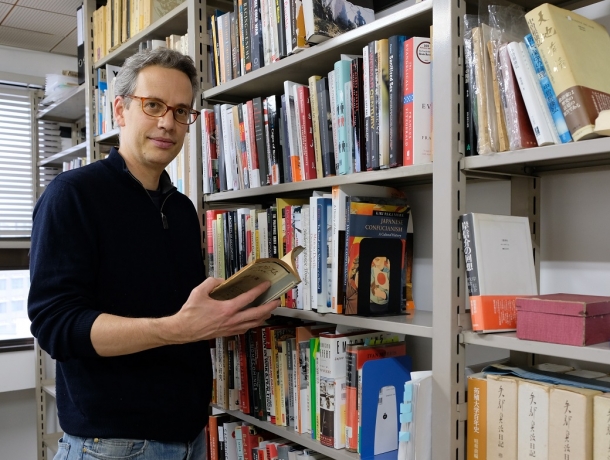
The author Dr. Hofmann
In this sense, this project is a corrective to the view that 1945 marked a clear rupture in the political culture of Japan. Liberal democracy did assert itself, but people like Yabe Teiji kept alive a culture of the Right that is often at odds with democratic principles.
Information
WIAS invites distinguished, internationally active researchers from overseas. Through scholarly exchanges, seminars, and other activities jointly undertaken with Waseda researchers, WIAS contributes to the invigoration of the university’s research activities. more information
Visiting Researchers
- April 1, 2019~May 1, 2019 RIVA, Angelo, Professor, Department of Finance, European Business School(France)
- April 1, 2019~May 1, 2019 KWON, Soo Young, Professor, Korea University Business School, Korea University(ROK)
- May 15, 2019~June 14, 2019 CHAI, Sun-Ki, Professor, Department of Sociology, University of Hawaii(USA)
- June 17, 2019~July 17, 2019 HAN, Doo Bong, Professor, Department of Food and Resource Economics, College of Life Science and Biotechnologies, Korea University(ROK)
- July 1, 2019~August 1, 2019 CASAL BÉRTOA, Fernando, Associate Professor, School of Politics and International Relations, University of Nottingham (UK)
- July 1, 2019~July 31, 2019 MEILHAN, Jean-Baptiste, Associate Professor, Institut Fourier, Grenoble Alpes University(France)
- July 1, 2019~July 31, 2019 YANG, Cheng-Ta, Professor, Department of Psychology, National Cheng Kung University(Taiwan)
- July 1, 2019~July 31, 2019 SYROS, Vasileios, Associate Professor, Department of Social Sciences & Philosophy, University of Jyväskylä(Finland)
Visiting Scholars
- April 22, 2019~May 22, 2019 LAINE, Richard M. Professor, Department of Materials Science and Engineering, University of Michigan(USA)
- June 1, 2019~July 1, 2019 TRIFONOVA, Temenuga, Associate Professor, Department of Cinema and Media Arts, York University(Canada)
- June 1, 2019~July 30, 2019 BIAN, Dongbo, Professor, School of Liberal Arts, Nanjing University(China)
- July 1, 2019~July 31, 2019 WANG, Dazhong, Assistant Professor, Business School, Sun Yat-sen University(China)
Please feel free to contact us.
Waseda Institute for Advanced Study (WIAS)
1-6-1 Nishi Waseda, Shinjuku-ku, Tokyo 169-8050, JAPAN
URL:https://www.waseda.jp/inst/wias/en/
TEL:03-5286-2460
FAX:03-5286-2470
E-mail:[email protected]
